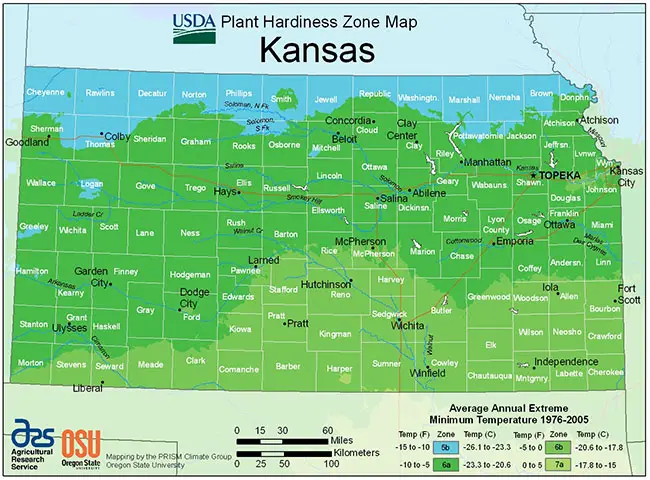
Kansas is not conducive to palm tree cultivation due to its predominantly cold climate. The state of Kansas experiences three distinct climate types: humid subtropical, humid continental, and semi-arid steppe.
Depending on the region, summers can be either hot and humid or hot and dry, with July maximum temperatures ranging from 91°F (32°C) to 93°F (33°C). Winters vary from cold to mild, and in some areas, even warm, with average maximum January temperatures spanning from 36°F (2°C) to 40°F (4°C).
Annually, Kansas receives approximately 46 inches of rainfall, but the amount of snowfall varies widely, ranging from around 5 inches (130 mm) to 35 inches (900 mm) depending on the specific location.
The state is also known for its frequent tornadoes and thunderstorms. The most extreme temperature recorded in Kansas was a scorching 121°F (49°C), while the lowest plummeted to a bone-chilling -40°F (-40°C). Kansas USDA hardiness zones encompass a range from 5b to 7a.
Growing Palm Trees in Kansas
The dynamic and often cold weather in Kansas presents challenges for palm tree growth. To successfully cultivate palm trees in this region, there are two recommended approaches: you can either create a warm microclimate within your yard or opt to grow palm trees indoors and bring them outside during the warmer summer months.
If you can establish a microclimate with temperatures similar to zone 7, you can consider growing the following palm tree varieties:
- Needle Palm Tree – Zones 5b-11 (-15 to -10F)
- European Fan Palm Tree – Zones 7b-11 (5 to 10 F)
- Pindo Palm Tree – Zones 7b-11 (5 to 10 F)
- Sago Palm Tree – Zones 7b-11 (5 to 10 F)
- Saw Palmetto Palm Tree – Zones 7a-11 (0 to 5 F)
- Windmill Palm Tree – Zones 7b-11 (5 to 10 F)
More Palm Trees»
Major Cities in Kansas
Kansas City – Hardiness Zone 6a
Overland Park – Hardiness Zone 6a
Shawnee Mission – Hardiness Zone 6a
Topeka – Hardiness Zone 6a
Wichita – Hardiness Zone 6a

Hello, I am from the city of Olathe and I was wondering if it would be possible to grow a date palm in my back yard?